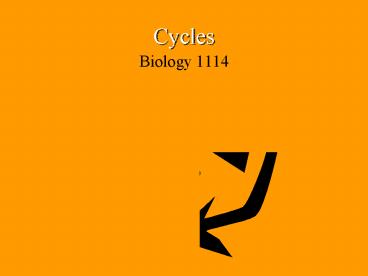Cycles - PowerPoint PPT Presentation
1 / 34
Title:
Cycles
Description:
Cycles Biology 1114 Definitions Community an association of interacting populations Habitat a place where an organisms lives characterized by distinctive ... – PowerPoint PPT presentation
Number of Views:36
Avg rating:3.0/5.0
Title: Cycles
1
Cycles
- Biology 1114
2
Definitions
- Community an association of interacting
populations - Habitat a place where an organisms lives
characterized by distinctive physical features
and vegetation - Niche the role played by the organism
3
Categories of Species Interactions
- Neutral neither affected
- Commensalism one benefited and one not affected
- Mutualism both benefit
- Parasitism one benefits and one is harmed
- Predation one benefits and one is harmed
4
Neutral
5
Commensal
6
Yucca Plant and Yucca Moth Are Mutualism
7
Predation
8
Parasitism
9
Predator-Prey Interactions
10
- Depends on
- Carrying Capacity
- Reproductive Rates
11
Parasite-Host Interactions
Ectoparasites live on a hosts surface Endoparasit
es live inside a hosts body
12
(No Transcript)
13
Trophic Levels
Trophic levels are the feeding position in a food
chain such as primary producers, herbivore,
primary carnivore, etc. Green plants form the
first trophic level, the producers. Herbivores
form the second trophic level, while carnivores
form the third and even the fourth trophic
levels.
14
(No Transcript)
15
Food Chain
16
Food Chain rose plant -- aphids -- beetle --
chameleon -- hawk.
In this food chain, the rose plant is the primary
producer. The aphids are the primary consumers
because they suck the juice from the rose plant.
The beetle is the primary carnivore because it
eats the aphids. The chameleon, a secondary
carnivore, eats the beetle. The hawk is the
tertiary carnivore because it eats the secondary
carnivore, the chameleon. The hawk eventually
dies and its remains are broken down by
decay-causing bacteria and fungi.
17
Food Web
18
(No Transcript)
19
Trophic Levels and Energy
20
(No Transcript)
21
Cycles in Nature
- Hydrologic (Water) Cycle
- Nitrogen Cycle
- Carbon Cycle
- Oxygen Cycle
- Phosphorous Cycle
22
Hydrologic Cycle
23
- The hydrologic cycle begins with the evaporation
of water from the surface of the ocean. As moist
air is lifted, it cools and water vapor condenses
to form clouds. Moisture is transported around
the globe until it returns to the surface as
precipitation. Once the water reaches the ground,
one of two processes may occur 1) some of the
water may evaporate back into the atmosphere or
2) the water may penetrate the surface and become
groundwater. Groundwater either seeps its way to
into the oceans, rivers, and streams, or is
released back into the atmosphere through
transpiration. The balance of water that remains
on the earth's surface is runoff, which empties
into lakes, rivers and streams and is carried
back to the oceans, where the cycle begins again.
24
(No Transcript)
25
(No Transcript)
26
Nitrogen Cycle
The nitrogen cycle is the biogeochemical cycle
that describes the transformations of nitrogen
and nitrogen-containing compounds in nature.
27
(No Transcript)
28
Carbon Cycle
Carbon is stored on our planet in the following
major sinks (1) as organic molecules in living
and dead organisms found in the biosphere (2) as
the gas carbon dioxide in the atmosphere (3) as
organic matter in soils (4) in the lithosphere
as fossil fuels and sedimentary rock deposits
such as limestone, dolomite and chalk and (5) in
the oceans as dissolved atmospheric carbon
dioxide and as calcium carbonate shells in marine
organisms.
29
(No Transcript)
30
Oxygen Cycle
The oxygen cycle is the biogeochemical cycle that
describes the movement of oxygen within and
between its three main reservoirs the
atmosphere, the biosphere, and the lithosphere.
The main driving factor of the oxygen cycle is
photosynthesis, which is responsible for the
modern Earth's atmosphere and life as we know it.
If all photosynthesis were to cease, the Earth's
atmosphere would be devoid of all but trace
amounts of oxygen within 5000 years. The oxygen
cycle would no longer exist.
31
(No Transcript)
32
(No Transcript)
33
Phosphorous Cycle
The phosphorus cycle is the biogeochemical cycle
that describes the movement of phosphorus through
the lithosphere, hydrosphere, and biosphere.
Unlike many other biogeochemicals, the atmosphere
does not play a significant role in the movements
of phosphorus, because phosphorus and
phosphorus-based compounds are usually solids at
the typical ranges of temperature and pressure
found on Earth.
34
(No Transcript)































